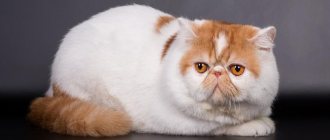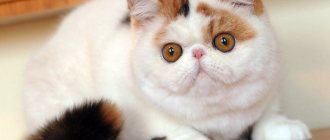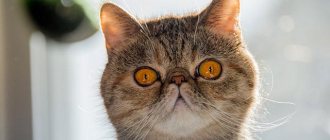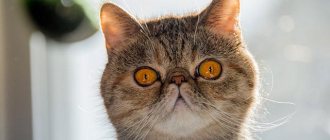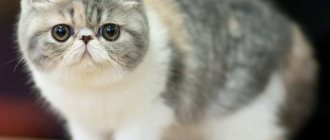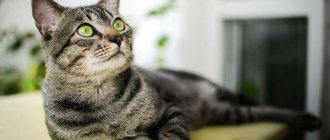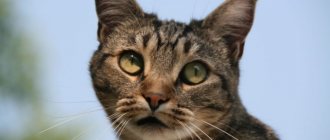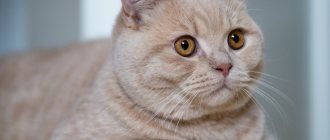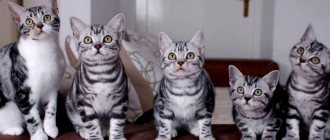The exotic cat breed, which appeared by chance in the middle of the last century, is considered one of the most popular today. Its representatives, looking like little bear cubs, have conquered the world with their cute faces, soft fur coat and friendly disposition. Before an exotic cat becomes a full-fledged member of the family, it is worth learning about the characteristics of the animal, its advantages and disadvantages, and studying recommendations for caring for your pet.
Exotic cat breed
History of the origin of the breed
Exotics owe their origin to a happy accident. One day, breeders of American Shorthair cats decided to cross them with Persians. Their goal was to obtain new coat colors and irises. In addition, the infusion of Persian blood would improve the appearance of aboriginal cats.
However, fate decreed otherwise - as a result of such crossing, unusual kittens with flat faces were born. Their exterior had almost nothing in common with representatives of the American Shorthair breed. The mestizos inherited the typical characteristics of the Persians, only the hair became short and soft.
A new breed called the Exotic Shorthair was introduced to the public in 1966. This caused a wave of indignation from fans of purebred Persians. They did not want to recognize exotics; they considered their creation an encroachment on the purity of the Persian breed. Breeders did not allow their pets to be mated with shorthaired cats, thereby preventing the development of a new variety.
Still, there were people who were loyal to the appearance of exotics. They gave their Persians for interbreeding. Other breeds were also used in the selection process: Russian Blue and Burmese. Their participation helped firmly consolidate the gene responsible for short hair.
Finally, the exotic breed was recognized. In 1990, felinologists managed to reach a compromise on the standard. The requirements for the exterior and colors of exotic cats are the same as for Persian cats. In 1993, crossbreeding with shorthair cats was stopped; from that time on, it was allowed to breed exotic cats only with Persians.
Description of the Snoopy cat breed
In the 20th century, Western scientists decided to crossbreed Persians with the American Shorthair. They wanted to ennoble the “American” and strengthen his skeleton. Russian blue cats and Burmese cats also took part in the crossing.
As a result, “fluffies” with short and thick hair, very similar to Persians, were born. It was a failure of the breeders. For many years, they did not want to classify the “bear cubs” as a separate breed, considering them Persians with “short hair.” Only in 1996 were exotics recognized. The second name of the breed is Snoopy, the cats received it in 2011, in honor of the Chinese star kitten.
As you can see in the photo, Snoopy's cats have funny faces with thick cheeks. They have a short plush coat, small round ears, and huge eyes.
The beauty standard includes the presence of a “foot” on the face. That is, a sharp transition from the nose to the forehead. At the same time, the animal has a large head and a powerful body. And a large bushy tail.
The cats themselves are quite heavy. However, the standards do not specify what the size of an exotic should be. Most often these are quite large pets. By the way, Garfield from the cartoon of the same name is also a prominent representative of the exotic breed.
There are several types of color recognized by the standard:
- Siamese;
- simple (one color);
- complexly colored: with or without a pattern.
The pattern itself can be spots, stripes or marbled colors. The lifespan of plush pets is approximately 8-10 years.
Description of the breed with photographs
An exotic breed of cat is shown in the photo. These are medium-sized animals with a height at the withers of about 30 cm and a weight of 5–7 kg. Their main features are a pretty face with a snub nose, an innocent look and soft thick fur.
Exterior standard requirements
The description of the breed gives the following characteristics of the cats' appearance:
- the head is medium in size and round in shape;
- wide, flat muzzle with well-developed cheeks and raised short nose;
- the jaws are wide, very strong;
- rounded chin;
- large round eyes are distant from each other and are on the same horizontal line;
- small ears with rounded tips are widely spaced and slightly tilted forward;
- the nose is wide, turned up, the stop is at eye level;
- the body is large, well-built, squat with developed muscles, a broad chest and a massive shoulder girdle;
- short powerful limbs with large rounded paws;
- medium-length tail densely covered with hair;
- The coat is about 1.5–2 cm long and has a thick undercoat.
Any exotic colors characteristic of Persian cats are recognized as the standard. The most popular are color point, silver, white, bicolor, cream, blue.
White exotic
Vices leading to disqualification:
- hind limb weakness;
- creases on the tail;
- the number of toes is atypical for the breed - there should be 4 on the back, 5 on the front;
- slanted eyes;
- irregular shape of the skull;
- Eye colors other than blue are found in color-point cats.
Character of an exotic cat
The appearance of these animals is in harmony with their character. Friendliness, playfulness and curiosity are their hallmarks. Exotics are suitable for both families with small children and single people. They become strongly attached to their owner, but show love delicately, so they cannot be called intrusive. The pet will wait until you are free, settle on your lap and dissolve in your arms.
Exotic cat red marble
The exotic cat has good adaptive qualities. In a new place, the kitten gets used to it in a couple of days. The main thing is to let him look around, smell everything and show the new family member that he is welcome here. These animals subtly sense a person’s mood. If it's a difficult day, the cat will try to relieve stress, calm and cheer up the owner. Let her lie next to you for a while and you will feel relieved.
Despite their apparent clumsiness, exotics are very mobile. They love to run after a ball, hunt for an interactive mouse, or catch a paper ball in flight. One of their favorite pastimes is playing with their tail. You can often catch your pet looking at himself in the mirror. Touching your reflection with your paw and leaning your nose against it gives exotics great pleasure.
Attention! Exotic cats have a well-developed hunting instinct. It is not recommended to keep them together with small rodents or birds.
Exotics get along well with small children; aggression is not typical for them. If the baby accidentally hurts the pet, he is not in any danger - the cat will retire to a safe place. Animals behave cautiously around strangers. The degree of their trust in new faces grows gradually. Let the guests who came to the house for the first time not be offended that the cat did not allow himself to be petted. Perhaps during the next visit they will be allowed to do so.
Black marble color
An exotic is a cat that becomes strongly attached to a person. She cannot be left alone for long. Separation from family members can result in illness. When going on a trip, take your pet with you. Snub-nosed beauties easily get along with dogs, but sometimes they get jealous if they lack attention.
Education and training
Raising an exotic cat is easy. These are smart and quick-witted animals that respect the rules established by the owner. Your pet will quickly remember how to use the tray and scratching post if you start training from the first days of being in the house. Some exotics even master different commands and simple tricks.
The owners of these cats advise raising their pets without using force or screaming. A disobedient pet should not be beaten. It is better to show patience and love, and use water as punishment. By lightly spraying the fidget, you can make him stop playing around. Rough treatment of an animal will lead to loss of trust on its part.
Health and life expectancy
The most common problem in exotic cats is tearfulness. The nasolacrimal duct in these animals is short, which is what provokes the secretion of tears. It is important to wipe your pet's eyes daily to remove dirt to prevent the development of conjunctivitis.
Black exotic cat
Exotics often suffer from colds and gum inflammation. Some animals have a crooked lower jaw, making it difficult for them to eat. From their Persian relatives, cats have inherited a tendency to form multiple cysts on the kidneys. If one of the kitten's parents was diagnosed with polycystic kidney disease, the disease is more likely to be passed on to the offspring.
Another common hereditary disease of exotics is cardiomyopathy. This is a pathology of the left ventricle of the heart. The disease is detected suddenly at any age, even in young cats. The main symptoms are shortness of breath, paleness of the mucous membranes, and fatigue. If a kitten exhibits such symptoms, it needs to be examined.
The average life expectancy of exotic shorthair cats is 13–14 years. With good care and proper nutrition, a pet can live up to 18 years.
Exotic cat care
Although these animals are a short-haired variety, their thick coat requires special care. You need to comb your pet every 2 days, but it is better to do it daily so that tangles do not appear on the fur. Neglecting this recommendation leads to the formation of bezoars in the digestive tract.
Exotics are washed once a month
Kittens are bathed 2 times a week, and adult animals - once a month. Thanks to water procedures, the growth of the undercoat is accelerated. Because the wool is very thick, it is difficult to wet it well. Do not rush to apply shampoo until the entire cover is wet. To prevent the fur from sticking together and remaining crumbly, it is recommended to use cat conditioner. It is applied to the pet’s body after shampooing and washed off after 2-3 minutes. After bathing, the wool is dried with a hairdryer at low speeds, setting the thermostat to the minimum temperature.
Attention! From the first days the kitten is in the house, accustom him to the hair dryer so that in the future he will not be afraid. Thick wool takes a very long time to dry, and the undercoat falls off, so you can’t do without the help of this device.
The eyes are the weak point of an exotic cat. You will have to buy a special solution to care for them and wipe off the discharge every day with a hypoallergenic napkin or a sponge soaked in boiled water. The external auditory canal is cleaned with a cotton pad every 7–10 days. It is recommended to trim the nails twice a month. Exotics tolerate these procedures normally if the kitten is accustomed to them from childhood.
Persian relatives are very clean. They don't like going into a dirty litter box. Try to clean there as often as possible. Once a month, the cat litter box should be washed, but without using chemicals. It is also important to monitor the cleanliness of the dishes from which your pet eats. This is especially important if your cat eats wet food. Do not allow uneaten pieces of food to remain in bowls. Drinking water needs to be changed every day.
It is recommended to buy a large, comfortable bed for a kitten - it will grow and become quite large. A place to spend the night is chosen near the owner, because exotic animals do not like to be alone. Before bringing your pet into your home, you should take safety precautions - these cats are clumsy and often careless, which means they can get into trouble. Install screens on windows, hide wires, and limit access to cabinets where an animal could fall.
Exotic cat hair care
Dental care is also very important. Cats that eat mostly natural food or canned food develop a thick plaque on their teeth. Over time, it hardens, which causes inflammation of the gums, gingitis. To prevent tartar, special treats are used.
Attention! Caring for a cat also includes taking care of its health. It is important to promptly treat your pet against helminths and skin parasites and get vaccinations that protect against deadly diseases.
Care
Exotics are not the most demanding pets to care for, however, and they have their own subtleties associated with thick hair and undercoat, as well as the structure of the skull bones.
Wool
Despite the dense plush coat, caring for it is not a big problem. It is enough to comb the animal once a week, during shedding - 2-3 times a week. To do this, you need to use a special brush in the form of a metal comb.
Bathing an exotic cat is recommended no more than once a month using a special cat shampoo.
Important! Do not use personal shampoos, soaps or shower gels - they can cause allergic reactions in your pet.
After a bath, it is advisable to dry the animal’s fur with a hairdryer, since due to its thickness, the damp undercoat can mat.
Nutrition
The combination of a good appetite and “lazy” games makes exotic cats prone to gaining excess weight. It is necessary to accustom an animal to a balanced diet from a very early age. The basis of the diet should be protein products combined with carbohydrate foods - cereals and vegetables. When feeding natural food, it is worth adding vitamin and mineral complexes to the diet.
Advice! For feeding, you need to choose tall bowls with edges curved inward, which will protect the animal’s fur from getting dirty with food.
When using dry food, it is better to give preference to the super-premium class. They contain balanced nutrients, vitamins, macro- and microelements. It is acceptable to supplement dry food with wet food from the same company. The amount of food should correspond to the recommendations on the packaging.
Important! Exotics in any form or quantity are prohibited from fatty, fried, smoked foods, milk and fish products. It is also prohibited to mix industrial and natural feeds - only alternation.
An adult cat is fed 2 times a day, kittens under 3 months of age - 6 times a day. At the age of 6-9 months, the feeding regimen is 4 times a day, then switch to two meals a day. Clean water should be available to your pet around the clock.
Caring for ears, eyes and claws
The special structure of the muzzle requires certain care. The eyes and nose should be wiped daily with a damp cloth that does not contain alcohol or fragrance. The ears are wiped once a week with a damp cloth or a bandage soaked in water. The kitten is accustomed to these procedures from a very early age.
Claws are trimmed 2 times a month using a special guillotine or nail clipper. A good scratching post is a must in the house.
A necessary procedure for the breed is brushing its teeth. It is carried out once a week using a soft baby brush or a special cat brush. For kittens, during the training process, the brush is only moistened with water, and for those already accustomed to the procedure, tooth powder without flavors is added.
Walking your pet
Walking is not necessary for exotics - they are a typical resident of an apartment or house. If you wish, you can walk your cat on a harness, but in this case you need to accustom it to it from a young age. You cannot release an animal without accompaniment and supervision, even in a closed private area.
Cats of this breed can easily tolerate traveling and moving.
Feeding recommendations
Experienced breeders recommend feeding your exotic cat premium or higher industrial food, as it already contains all the substances necessary for health. Cats of this breed have a peculiarity - they get used to one type of food and then refuse another food. For this reason, it is better to immediately accustom the animal to good food.
Attention! Exotics are famous for their excellent appetite and have a tendency to obesity. Do not overfeed your pet. An adult cat requires about 150 g of food per day, a cat - 135 g. Food is distributed 2-3 times a day, kittens are fed 4 times a day.
It is allowed to introduce foods from the human table into the diet, but not all food is healthy for cats. You can treat your favorite:
- rabbit, veal, chicken or turkey fillet;
- fermented milk products – fermented baked milk, kefir, a small amount of sour cream;
- oatmeal or rice cooked in water without adding salt;
- a small piece of cheese.
Prohibited foods are milk, sweets, salty, fatty, fried foods, potatoes, bones.
Snoopy cat care and nutrition
Such unusual cats are exotic Snoopy and require special care. Unlike other short-haired animals, they require careful grooming.
Although Snoopy's fur is short, it is no less than that of the Persians. Plus there is a thick undercoat underneath. To avoid tangles, you need to comb out the “cubs” at least twice a week.
It is recommended to immediately instill in kittens a love of the bath, because these animals require monthly bathing. But the face needs to be cleaned with a damp cloth every day.
If cats develop tear tracks, they should be removed with special means. Also, you need to carefully monitor the teeth of the “buns”, buy cleaning bones, and from time to time look into the animal’s mouth.
Unfortunately, the breed is susceptible to genetic diseases. Cats may develop breathing problems, lacrimation, or, conversely, obstruction of the tear duct. Preventative visits to the veterinary clinic are recommended in order to promptly diagnose the disease and begin treatment.
When it comes to food, exotics are usually unpretentious. Owners should opt for balanced cat food or high-quality “natural” cat food. The diet must include:
- Dairy products. Kefir, fermented baked milk, sour cream. At the same time, fresh fermented milk can cause stomach upset, so it is worth giving the products on the second or third day from the date of manufacture.
- Meat.
- Vegetables and cereals.
- Vitamins for cats.
Babies up to three months of age are fed 6 times a day, kittens up to six months old - 4 times, and adult Snoopy - in the morning and evening. In addition, it is important to leave a bowl of clean drinking water in a place accessible to the cat.
Breeding Features
Breeding exotic cats has its own nuances. The fact is that only 50–75% of kittens are born with short hair, the rest have long hair. Most felinological organizations, except for the CFA and GCCF, classify kittens with long hair born from exotic cats as the Persian breed.
Longhair exotic
Animals belonging to the show and breeding classes are used for breeding. Puberty in cats occurs at 8 months. Females who have already had several heats are allowed to crossbreed. It is customary to arrange a date for a couple on the territory of the gentleman. Cats do not immediately allow the groom to approach them; they need time to get comfortable and get to know their chosen one. Mating is considered successful if, 4 weeks after it, the female does not begin another estrus.
Cost of a kitten
Prices for kittens range from 15,000–70,000 rubles. The cost depends on the pedigree, titles of the parents and the class to which the animal belongs. The most expensive cats belong to the show class; they have no defects in appearance and receive high marks at exhibitions. By purchasing a pet-class kitten, you can save money. Such animals are not allowed for breeding, as they do not meet the standard, but they may well become a faithful friend for the family.
It is better to buy an animal from professional breeders, in registered nurseries. Their owners value their reputation, so they will not deceive customers. Breeders have all the documents for their cats, which can be studied before concluding a purchase and sale agreement. Kittens are adopted at the age of 12 weeks, when they are already litter box trained, vaccinated and socialized. The breeder will tell you how to care for the pet and what care products the new owner will need.
Reviews about exotic cats
Owners speak of their pets as exceptionally gentle and good-natured creatures. According to them, these animals are very quiet, moderately playful, inquisitive and friendly. They will never rush at a person or offend him. Cats are clean and do not smell. Pets show interest in everything new - they strive to touch unfamiliar objects with their paws and smell them. Reviews about the breed are only positive.
Those who want to get an exotic cat need to be prepared to give it a lot of attention. If the work involves business trips, it is better to choose another breed, since exotics have a hard time withstanding separation from a person.
Features of the Snoopy breed
Before you buy a cat Snoopy , you should get to know the beauty's character. It is suitable for those who dream of acquiring a faithful and gentle friend. The breed is distinguished by its developed intelligence and good memory.
Representatives of the breed are not known for their talkative nature. They do not beg for food and usually do not greet the owner when they meet. Snoopy's voice is rarely heard. Only if the cat really really needs something.
It is very difficult to “irritate” exotics. They are serene and friendly. Ideal for families with small children or other pets. These cats are not called companions for nothing.
True, sometimes the big-eyed “bear cubs” are possessed by an “imp”, they begin to actively run and play quite noisily. Cats especially love it when people pay attention to their “races.” If there is an audience, the performance can last quite a long time.
Otherwise, Snoopy's personality resembles that of dogs. They are loyal and dedicated. At the same time, from the whole family, they single out one owner for themselves and tie them more closely to him. But trust must be earned.
Before a cat recognizes its owner, it can watch him for a long time. Exotics get bored alone and have a hard time with partings. But you can travel with “plush” cats. They endure the road easily.
